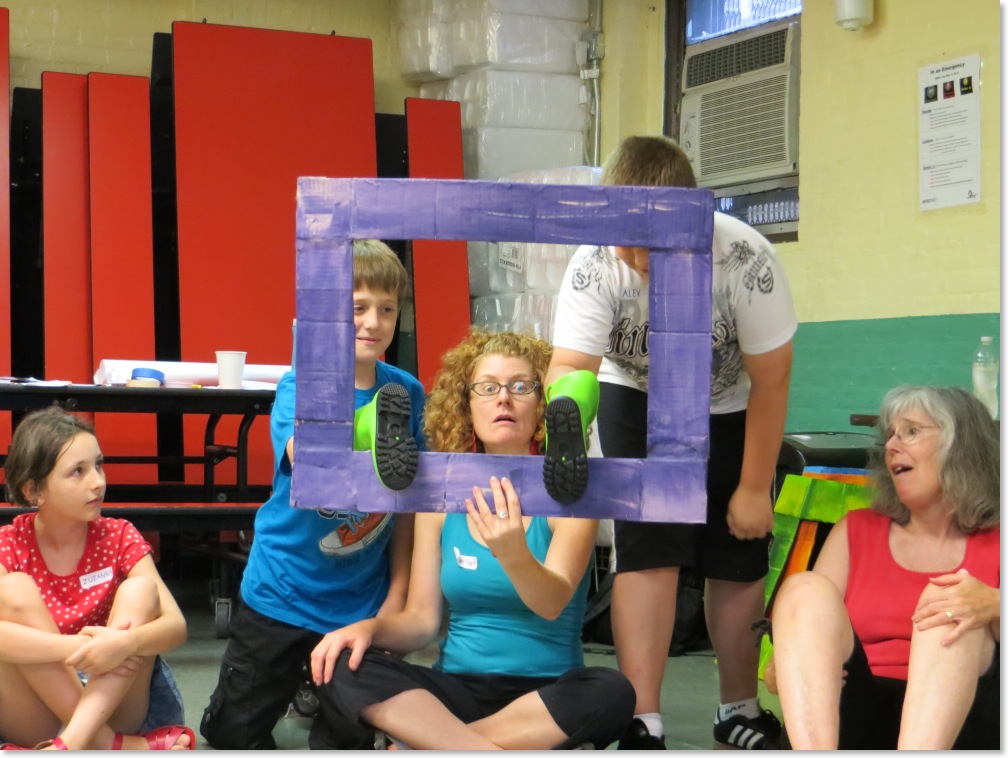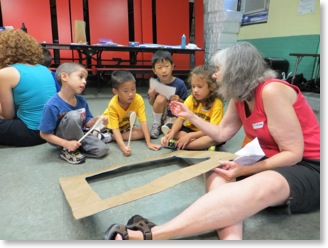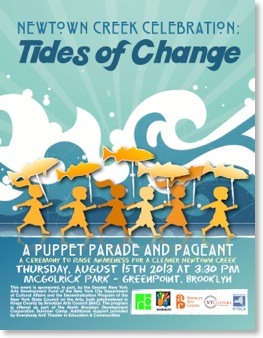Session One Revised: One Year Later
Friday, August 02, 2013 | Filed in: Newtown Creek Celebration
 by Kevin Ray
by Kevin RayRepeating a community based arts project one year later offers a wonderful opportunity: a chance to do things differently the second time around! After reflecting on our 2012 session plans for Newtown Creek Celebration: Puppet Parade and Pageant, teaching artists Heather Nielsen, Sherry Teitelbaum and I realized that we overlooked an important element: we did not incorporate basic puppetry concepts into our session designs. We never asked the youth questions like: “What is a puppet?”, “Who uses puppets and what do they use them for?” and “As puppeteers, how do we bring inanimate object to life?” We didn’t facilitate hands on activities to develop the youth’s basic puppetry skills. Instead, we jumped right into building puppets and creating a show. Although our 2012 culminating event was very successful, we wished we had built the youths’ puppeteering skills before we began creating the show. So when we received two grants from Brooklyn Arts Council to reprise the project in 2013, we were determined to take a different approach, starting on day one.
What’s It All About?
Newtown Creek Celebration: Puppet Parade and Pageant is a free, ten-session theater and puppetry project for over 80 young people enrolled in North Brooklyn Development Corporation’s Summer Day Camp. Over the course of ten days, we work with youth to create an original puppet parade and pageant that explores issues relating to the pollution of Newtown Creek and the effect pollution has on the surrounding Greenpoint community. Each day, Heather, Sherry and I see four different groups of approximately 20 youth participants ranging in age from 5 to 11. During our session time, we work toward building puppets with the youth, then putting the puppets into the young peoples’ hands to devise an original show.This Is How We Do It
We wanted the young people to master the skill of bringing an inanimate puppet to life so we designed a first session that introduced basic puppetry skills culminating in short, youth created, puppet shows. Early in the session, we asked our participants to tell us what they already knew about puppetry. We asked them what they thought a puppet was and we asked them if they knew about different kinds of puppets. We were delighted when they articulated a range of puppets including sock puppets, string puppets, and something called a “cone puppet.” After we assessed their prior knowledge, we showed them a few examples of puppets that we brought in. Next we told the youth that they were going to create a puppet show using sounds and movements, but not words. We developed the skill of matching sounds to emotions by asking the young people to make sounds that they associated with various feelings like being “sad”, “excited”, and “surprised.” After we had some fun making emotional sounds, we explained that they were going to use those types of sounds in their puppet shows. However, the puppet shows that the youth created were not done with fully formed puppets. Instead,
- First, show the puppets still in the middle of the frame
 .
. - Then show the puppets feeling scared with a sound and a movement.
- Next show the puppets feeling excited with a sound and a movement.
- Last, show the puppets taking a bow.
We had a fantastic time leading our revised day one session with the youth! We think this skill building workshop will serve us well as we continue on to the next step of the process: building puppets. Stay tuned for more as we blog our progress leading up to our culminating event.
Come and see our show!
If you would like to attend our free performance. Visit our Facebook Event page by clicking here. Let us know you are coming or post an encouraging comment on our event page. We hope to see you there.Make a Donation Today!
Our crowd funding campaign is off to a great start! Thank you so much to everyone who has already contributed. We are offering lots of different perks to folks who support the project including our 2013 poster, photos of the culminating event, or a puppet from the show to take home! If you would like to make a donation, click on the widget to the right or click here. If you want to support the project but can’t make a financial contribution, there are other ways to help out!- Visit the campaign page and click the “like”, “tweet”, or google plus icons to spread the word about our campaign to your friends on social media.
- Post a comment at the end of this blog.
- Forward this blog post to other people you think might like to hear about our work.
- Come join us at our free culminating event on August 15th, at 3:30 in McGolrick Park, Brooklyn.
This event is sponsored, in part, by the Greater New York Arts Development Fund of the New York City Department of Cultural Affairs and the Decentralization Program of the New York State Council on the Arts, both administered in Kings County by Brooklyn Arts Council (BAC).
blog comments powered by Disqus

